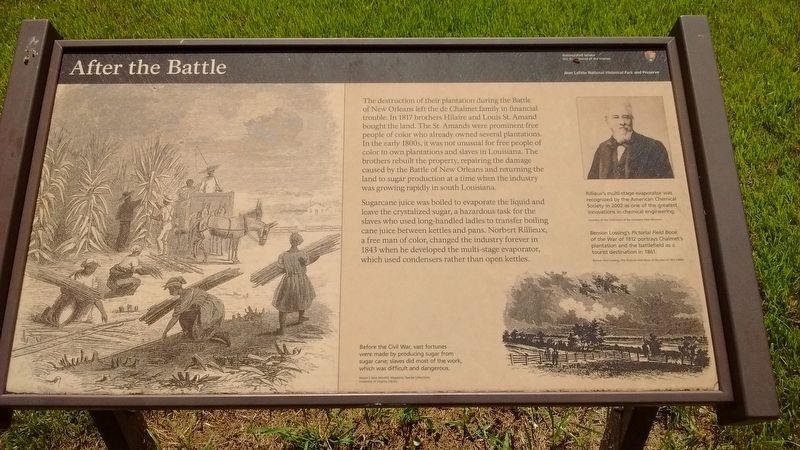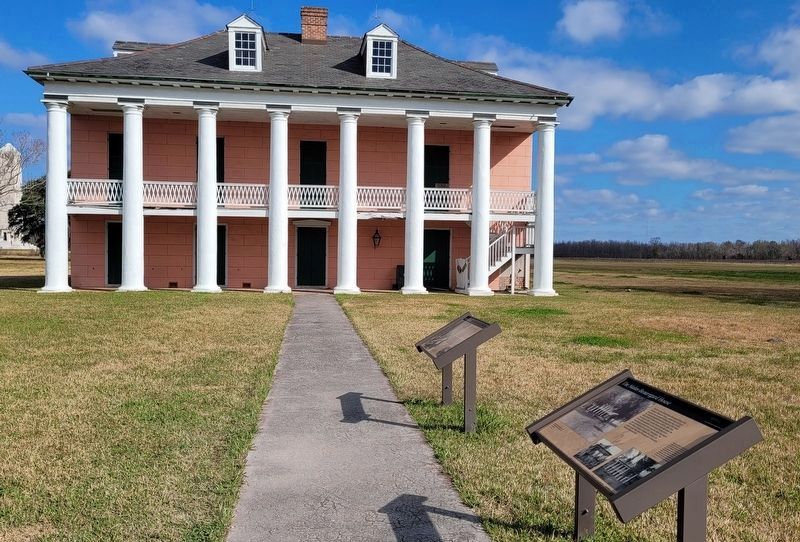Chalmette in St. Bernard Parish, Louisiana — The American South (West South Central)
After the Battle
Jean Lafitte National Historical Park and Preserve
The destruction of their plantation during the Battle of New Orleans left the de Chalmet family in financial trouble. In 1817 brothers Hilaire and Louis St. Amand bought the land. The St. Amands were prominent free people of color who already owned several plantations. In the early 1800s, it was not unusual for free people of color to own plantations and slaves in Louisiana. The brothers rebuilt the property, repairing the damage caused by the Battle of New Orleans and returning the land to sugar production at a time when the industry was growing rapidly in south Louisiana.
Sugarcane juice was boiled to evaporate the liquid and leave the crystalized sugar, a hazardous task for the slaves who used long-handled ladles to transfer boiling cane juice between kettles and pans. Norbert Rillieux, a free man of color, changed the industry forever in 1843 when he developed the multi-stage evaporator, which used condensers rather than open kettles.
(captions)
Rillieux's multi-stage evaporator was recognized by the American Chemical Society in 2002 as one of the greatest innovations in chemical engineering.
Benson Lossing's Pictorial Field Book of the War of 1812 portrays Chalmet's plantation and the battlefield as a tourist destination in 1861.
Before the Civil War, vast fortunes were made by producing sugar from sugar cane; slaves did most of the work, which was difficult and dangerous.
Erected by National Park Service - United States Department of the Interior.
Topics. This historical marker is listed in these topic lists: African Americans • Industry & Commerce. A significant historical year for this entry is 1817.
Location. 29° 56.424′ N, 89° 59.656′ W. Marker is in Chalmette, Louisiana, in St. Bernard Parish. Marker is on River Road, 0.7 miles west of Pompano Drive, on the right when traveling west. Marker can be reached from Battlefield Road within the Chalmette Battlefield portion of the Jean Lafitte National Historical Park and Preserve. Touch for map. Marker is in this post office area: Chalmette LA 70043, United States of America. Touch for directions.
Other nearby markers. At least 8 other markers are within walking distance of this marker. The Malus-Beauregard House (here, next to this marker); Chalmette Battlefield And National Cemetery (a few steps from this marker); The West Bank Assault (within shouting distance of this marker); Battery One and Forward Redoubt (about 300 feet away, measured in a direct line); Attack Along the River (about 300 feet away); Batteries Two and Three (about 300 feet away); Chalmet Plantation (about 300 feet away); In Memory of Major Samuel Spotts U.S.A. (about 300 feet away). Touch for a list and map of all markers in Chalmette.
Also see . . . Chalmette Battlefield. NPS Jean Lafitte National Historical Park and Preserve website entry (Submitted on August 22, 2016, by Tom Bosse of Jefferson City, Tennessee.)
Credits. This page was last revised on January 15, 2023. It was originally submitted on August 22, 2016, by Tom Bosse of Jefferson City, Tennessee. This page has been viewed 555 times since then and 40 times this year. Photos: 1. submitted on August 22, 2016, by Tom Bosse of Jefferson City, Tennessee. 2. submitted on January 13, 2023, by James Hulse of Medina, Texas. • Bernard Fisher was the editor who published this page.

